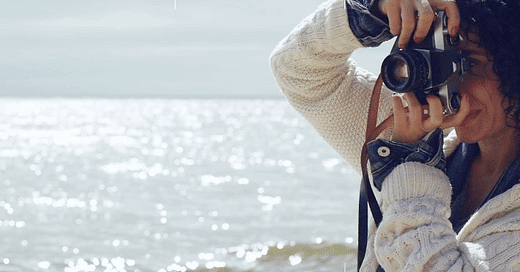Camera Sensor Safety: Shoot Sun Without Damage
Golden hour turns landscapes magical—until your camera sensor fries.
We’ve all taken that risky shot: sun flares look amazing, but your gear feels way too hot.
What if you could chase those fiery sunbeams—starting today—without the fear?
Truth is it’s not luck.
It’s about three simple rules (filters, timing, settings) even pros swear by.
→ Let’s torch the myths, bulletproof your sensor, and turn sunlight into your creative ally:
⚠️ The Real Risks (No Hype)
Camera sensors can suffer sun damage, but it’s not as simple as “never shoot toward the sun.”
Your sensor can get sunburned—but only under specific conditions.
The danger depends on four key factors:
Lens Choice
Wide-angle lenses (≤35mm): Safe for most scenarios. The sun appears small, dispersing light across the sensor.
Telephoto lenses (≥200mm): Act like magnifying glasses, concentrating sunlight. Use caution and filters.
“A lens is a magnifying glass—focusing sunlight into a pinpoint of heat. Treat it like your eye: if it’s too bright to stare at, don’t point your camera.” – Silvan L., ARRI Technician
Exposure Time
Short exposures (1/1000s): Generally safe, even with the sun in-frame.
Long exposures/live view: Heat builds up, risking sensor damage. Avoid uninterrupted sun tracking.
Camera Type
Mirrorless vs. DSLR: Both face similar risks—mirrorless aren’t inherently weaker. The shutter protects DSLRs when inactive, but live view negates this.
DSLR shutters shield sensors when powered off. Mirrorless sensors stay exposed even in standby mode.
Environmental Factors
Golden hour’s softer light is safer than harsh midday sun.
Haze or clouds act as natural diffusers, reducing intensity.
📸 Pro Tip: Telephotos act like magnifying glasses—great for detail, risky for sensors. Use ND filters here religiously.
🛡️ 5 Non-Negotiables for Sensor Safety
1. Lens & Filter Rules
Wide-angle sunscapes: No filter needed (keep it brief).
Telephoto close-ups: Mandatory ND 3.0+ or solar filter.
Sunstars (f/11–f/16): Narrow apertures = safer + sharper spikes.
🔗 Planning eclipse photography? Use my Solar Eclipse Safety Checklist.
2. Exposure Discipline
Bracket shots to avoid prolonged sun exposure.
Histogram hack: Keep highlights kissing the right edge.
ND filters: Slash light by 87% with a 3-stop ND.
Sun Intensity Calculator:
Use the Sunny 16 Rule to gauge when ND filters are non-negotiable:If your desired aperture is wider than f/16 at 1/ISO → Deploy ND filters.
Example:
Shooting at ISO 100? Sunny 16 baseline = f/16 at 1/100s.
Want f/8 for shallow depth of field? That’s 2 stops brighter than f/16.
Solution: Add a 2-stop ND filter (ND 0.6) to maintain safe exposure.
Key: “Stops brighter” = How much your settings exceed the Sunny 16 baseline.
3. Gear Hygiene
Never leave a tripod-mounted telephoto aimed at the sun.
Lens hoods: Block stray light and reduce flare.
Hot pixel checks: Scan images for permanent white spots.
⚠️ Never attempt sun-centric timelapses without professional ND filters. ARRI technicians warn static telephoto shots can melt sensors in minutes.
🔗 For deep cleaning tips, see my Step-by-Step Sensor Cleaning Guide.
4. Smart Timing
Golden hour priority: Softer light + easier dynamic range.
Avoid midday: Harsh light = higher thermal risk.
5. Phone Photography?
Low risk: Tiny sensors/lenses disperse light safely.
But: Prolonged 4K video can overheat devices—keep it snappy.
💥 Debunking 3 Common Myths
Myth 1: Mirrorless cameras are more vulnerable.
Truth: Risk depends on lens choice and exposure time—not mirror mechanics.
Myth 2: All sun shots require filters.
Truth: Wide-angle, quick exposures are safe filter-free.
Myth 3: Smartphones can’t handle sun photos.
Truth: Their small lenses disperse light effectively—just avoid extended video.
🔗 See my Smartphone vs. DSLR Sun Safety Comparison for side-by-side tests.
🌅 Creativity Without Compromise
Sunlit photography is not complex.
You just need to follow basic physics principles.
Pair these tips with your creativity:
Backlit drama: Position subjects between you and the sun.
🔗 Master telephoto creativity with my Plane Spotting Lens Guide.
Side lighting: Carve landscapes with texture-rich shadows.
Overcast days: Exploit nature’s softbox for risk-free magic.
Your Sensor’s Survival Kit
ND 3.0 filter (telephoto essential)
Lens hood (always attached)
Exposure bracketing (habitual)
🌡️ Sensor Damage Self-Check
Run this quick audit before sun-centric shoots:
☑️ No hot pixels in recent shots
Scan test images for permanent white dots—a sign of sensor stress.☑️ Lens hood attached during sun work
Blocks stray light and reduces flare-induced sensor strain.☑️ Timelapses use ND 3.0+ filters
ARRI warns static telephoto timelapses melt sensors in minutes if unfiltered.
Horror stories stem from being reckless, not artistry.
With these tactics, you’ll chase sunbeams with confidence—no casualties.
-Hakan
Founder, PhotoCultivator.com







